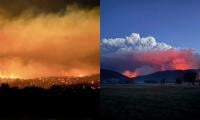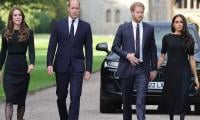The hidden land
In the curiously inter-mixing, constantly interchanging world of social media, images of many kinds blend together. Right now we have pictures from Yemen where conflict threatens to draw in Pakistan as well, from Kenya where nearly 150 university students died in a militant raid and of course the usual depictions
By Kamila Hyat
April 09, 2015
In the curiously inter-mixing, constantly interchanging world of social media, images of many kinds blend together. Right now we have pictures from Yemen where conflict threatens to draw in Pakistan as well, from Kenya where nearly 150 university students died in a militant raid and of course the usual depictions of family life from around the world.
But there are also other images, poignant ones, sad ones, highlighting what has happened to us as a nation. They show the blossoms – pink, white and peach – bringing alive the valleys of Gilgit and Hunza. There are other pictures of spring flowers in Lahore, of snow-covered homes in Murree and of the stunningly beautiful peaks and lakes of the north.
There are also more occasional images from the deserts of Tharparkar and Cholistan, from shrines across the country and remote, rugged locales that even today remain visited by only a few.
Such images should ordinarily be joyous ones. As a country we lay claim to the world’s greatest mountain ranges, to some of its most ancient cities and to landscapes and urban centres each with individual characteristics. Just as countries like Nepal, Sri Lanka and others have achieved, we should be earning substantial income from tourism.
The tourist industry can be a huge one, offering thousands of people income and livelihood from the hotel industry, from cafes and from all kinds of other occupations rooted in tourism and its various aspects. This was indeed once the case in our country. We have lost badly because the country, despite its stunning beauty, is no longer a place anyone is willing to visit. There are those who have faced possible abduction – or worse.
In 2011, a Swiss couple visiting Balochistan was apparently abducted by the Taliban; they were able to escape only after about a year in captivity. At least they got away alive. Worse still was the fate of the 10 mountaineers from a host of countries who were massacred in Gilgit-Baltistan near the base camp of Nanga Parbat in 2013 by militants determined to shed the blood of foreigners.
That one incident has shattered the previously peaceful reputation of the Gilgit area, which has largely been able to escape the worst wrath of militancy and destroyed the once booming climbing tradition in Pakistan, where mountaineers from around the world queued up for permission to scale the peaks in the Hindu Kush and Himalayas.
What we have lost is immense. It involves not only revenue or jobs but also the image of the country and its perception by the world. Today, Pakistan is looked at as one of the most dangerous places on earth. This of course is not an unfair reputation. We have done a great deal to earn it. The failure to combat militancy is the key factor in this, but other failures such as the unsuccessful bid to control polio also play a part in presenting the country as a hostile place unsafe for others to visit.
This disguises the fact that, for the most part, our people are astonishingly hospitable, willing to go miles out of their way to accommodate visitors and immensely generous in sharing what little they have. This truth about the people of Pakistan is known to too few. The country has become increasingly isolated in the world, its image terribly distorted as a result of poor governance and the terror that this has helped breed. The fact that this has happened has an impact on many lives. Students find it harder to obtain visas to study abroad, business travel is harder and life tougher for Pakistanis who live overseas or visit other nations. This is not a good place to be in.
As a result of what has happened, spots that were once landmarks in the country have vanished one by one. They include the legendary Khan Klub in Peshawar, an exquisitely done up boutique hotel located in a Hindu haveli in the heart of the city and opened in 1995 by an Irish American visitor, who fell in love with his adopted city, and a local entrepreneur who for years ran the hotel. Tourists for years raved about the rooms named after gemstones and the uniquely Pakhtun ambiance of the setting.
Today, it has become a warehouse where flour (aata) is stored. After 2001, the place became increasingly impossible to run because no one was willing to visit Pakistan. There have been other charming guesthouses in many places that have faced much the same fate.
This is distressing. The news that goes out about Pakistan does not help matters at all. It is often bleak; just as often tragic, involving attacks on churches or bombings at other places. We need to make an effort to open up our country to the world. To make its wondrous landscapes more accessible not only to foreigners but also those within the country who at present fear travel in many areas because of security issues.
These issues have come to strangle us and take a terrible hold on our lives. They have also taken a hold on our country. School trips to northern areas are now rarer than ever before; and after the attack on the school in Peshawar, they are less likely to take place in the near future. We have a generation which is then increasingly cut off from the wonders of its own country and of course all these are already hidden from the world outside.
It is sometimes a shock to look on at the pictures from the 1960s and 1970s when tourists, including hippies in floral shirts rode trucks across the country and freely roamed the streets of major cities. They can no longer safely do so today. Even the few westerners who live in parts of the country are regarded as being under threat. Safety warnings go out regularly from embassies. Pakistan is simply not seen as safe, and we all know the reasons for this.
It is these reasons and these realities that have to be changed. We cannot wait much longer to do this. The image that rises before the world today when Pakistan is mentioned is well entrenched. People do not see the dancing cherry blossoms. They see instead bodies felled by guns and bombs. We can alter this only by establishing new policies and working with genuine purpose to eliminate this scourge of militancy and the mindsets that have arisen with it.
Extremism has to end. Just as the image of Pakistan has been warped, our own perceptions about the west and its people are in many ways distorted. We need to straighten out things and create a route which allows people to once again take flights which land at airports in Pakistan and ride coaches or other vehicles to its more remote locations. Currently, this is not happening.
The loss is ours and the picturesque photographs that enthral those who see them have been restricted to a limited space available to them only on the social media or the pages of magazines from where they stare out at the world, as a forbidden zone within which no one is able to tread and explore all that lies within this magical realm.
This is surely one of our biggest tragedies. We have closed our doors to the world, and the world has closed them to us.
The writer is a freelance columnist and former newspaper editor
Email: kamilahyat@hotmail.com
But there are also other images, poignant ones, sad ones, highlighting what has happened to us as a nation. They show the blossoms – pink, white and peach – bringing alive the valleys of Gilgit and Hunza. There are other pictures of spring flowers in Lahore, of snow-covered homes in Murree and of the stunningly beautiful peaks and lakes of the north.
There are also more occasional images from the deserts of Tharparkar and Cholistan, from shrines across the country and remote, rugged locales that even today remain visited by only a few.
Such images should ordinarily be joyous ones. As a country we lay claim to the world’s greatest mountain ranges, to some of its most ancient cities and to landscapes and urban centres each with individual characteristics. Just as countries like Nepal, Sri Lanka and others have achieved, we should be earning substantial income from tourism.
The tourist industry can be a huge one, offering thousands of people income and livelihood from the hotel industry, from cafes and from all kinds of other occupations rooted in tourism and its various aspects. This was indeed once the case in our country. We have lost badly because the country, despite its stunning beauty, is no longer a place anyone is willing to visit. There are those who have faced possible abduction – or worse.
In 2011, a Swiss couple visiting Balochistan was apparently abducted by the Taliban; they were able to escape only after about a year in captivity. At least they got away alive. Worse still was the fate of the 10 mountaineers from a host of countries who were massacred in Gilgit-Baltistan near the base camp of Nanga Parbat in 2013 by militants determined to shed the blood of foreigners.
That one incident has shattered the previously peaceful reputation of the Gilgit area, which has largely been able to escape the worst wrath of militancy and destroyed the once booming climbing tradition in Pakistan, where mountaineers from around the world queued up for permission to scale the peaks in the Hindu Kush and Himalayas.
What we have lost is immense. It involves not only revenue or jobs but also the image of the country and its perception by the world. Today, Pakistan is looked at as one of the most dangerous places on earth. This of course is not an unfair reputation. We have done a great deal to earn it. The failure to combat militancy is the key factor in this, but other failures such as the unsuccessful bid to control polio also play a part in presenting the country as a hostile place unsafe for others to visit.
This disguises the fact that, for the most part, our people are astonishingly hospitable, willing to go miles out of their way to accommodate visitors and immensely generous in sharing what little they have. This truth about the people of Pakistan is known to too few. The country has become increasingly isolated in the world, its image terribly distorted as a result of poor governance and the terror that this has helped breed. The fact that this has happened has an impact on many lives. Students find it harder to obtain visas to study abroad, business travel is harder and life tougher for Pakistanis who live overseas or visit other nations. This is not a good place to be in.
As a result of what has happened, spots that were once landmarks in the country have vanished one by one. They include the legendary Khan Klub in Peshawar, an exquisitely done up boutique hotel located in a Hindu haveli in the heart of the city and opened in 1995 by an Irish American visitor, who fell in love with his adopted city, and a local entrepreneur who for years ran the hotel. Tourists for years raved about the rooms named after gemstones and the uniquely Pakhtun ambiance of the setting.
Today, it has become a warehouse where flour (aata) is stored. After 2001, the place became increasingly impossible to run because no one was willing to visit Pakistan. There have been other charming guesthouses in many places that have faced much the same fate.
This is distressing. The news that goes out about Pakistan does not help matters at all. It is often bleak; just as often tragic, involving attacks on churches or bombings at other places. We need to make an effort to open up our country to the world. To make its wondrous landscapes more accessible not only to foreigners but also those within the country who at present fear travel in many areas because of security issues.
These issues have come to strangle us and take a terrible hold on our lives. They have also taken a hold on our country. School trips to northern areas are now rarer than ever before; and after the attack on the school in Peshawar, they are less likely to take place in the near future. We have a generation which is then increasingly cut off from the wonders of its own country and of course all these are already hidden from the world outside.
It is sometimes a shock to look on at the pictures from the 1960s and 1970s when tourists, including hippies in floral shirts rode trucks across the country and freely roamed the streets of major cities. They can no longer safely do so today. Even the few westerners who live in parts of the country are regarded as being under threat. Safety warnings go out regularly from embassies. Pakistan is simply not seen as safe, and we all know the reasons for this.
It is these reasons and these realities that have to be changed. We cannot wait much longer to do this. The image that rises before the world today when Pakistan is mentioned is well entrenched. People do not see the dancing cherry blossoms. They see instead bodies felled by guns and bombs. We can alter this only by establishing new policies and working with genuine purpose to eliminate this scourge of militancy and the mindsets that have arisen with it.
Extremism has to end. Just as the image of Pakistan has been warped, our own perceptions about the west and its people are in many ways distorted. We need to straighten out things and create a route which allows people to once again take flights which land at airports in Pakistan and ride coaches or other vehicles to its more remote locations. Currently, this is not happening.
The loss is ours and the picturesque photographs that enthral those who see them have been restricted to a limited space available to them only on the social media or the pages of magazines from where they stare out at the world, as a forbidden zone within which no one is able to tread and explore all that lies within this magical realm.
This is surely one of our biggest tragedies. We have closed our doors to the world, and the world has closed them to us.
The writer is a freelance columnist and former newspaper editor
Email: kamilahyat@hotmail.com
-
 Indonesia Blocks Elon Musk’s Grok AI: A Global First In Deepfake Crackdown
Indonesia Blocks Elon Musk’s Grok AI: A Global First In Deepfake Crackdown -
 Royal Expert Optimistic About Lilibet, Archie Meeting With King Charles
Royal Expert Optimistic About Lilibet, Archie Meeting With King Charles -
 Sam Worthington Finally Reveals How He Got Lead Role In 'Avatar'
Sam Worthington Finally Reveals How He Got Lead Role In 'Avatar' -
 Lego’s ‘Smart Bricks’: A Pivot Towards Technology And Why It Matters
Lego’s ‘Smart Bricks’: A Pivot Towards Technology And Why It Matters -
 Bradley Cooper's Surgery Denials Make Things Even Worse
Bradley Cooper's Surgery Denials Make Things Even Worse -
 Nintendo Mario Toy Ads Spark Generative AI Controversy
Nintendo Mario Toy Ads Spark Generative AI Controversy -
 OpenAI, Common Sense Media Back AI Safety Ballot: What It Means For Kids & Parents
OpenAI, Common Sense Media Back AI Safety Ballot: What It Means For Kids & Parents -
 Apple And Google Face Scrutiny Over X Deepfake Content
Apple And Google Face Scrutiny Over X Deepfake Content -
 Andrew Likely To Plunge Royal Family Into Fresh Crisis As Former Duke Weighing Major Offer
Andrew Likely To Plunge Royal Family Into Fresh Crisis As Former Duke Weighing Major Offer -
 'Mixed Dementia' Myth Debunked By Expert
'Mixed Dementia' Myth Debunked By Expert -
 Roger Ewing, 'Gunsmoke' Actor Dies At 83
Roger Ewing, 'Gunsmoke' Actor Dies At 83 -
 Friends Warn Meghan Markle About Prince Harry As Duke Plans Olive Branch To King Charles
Friends Warn Meghan Markle About Prince Harry As Duke Plans Olive Branch To King Charles -
 Sarah Ferguson Slammed As Her Exit Strategy Falls Apart
Sarah Ferguson Slammed As Her Exit Strategy Falls Apart -
 Australia On Alert: State Of Disaster Declared As Victoria’s Bushfires Rage
Australia On Alert: State Of Disaster Declared As Victoria’s Bushfires Rage -
 Bucks Vs Lakers: Giannis, Dončić Headline Tight Contest In Los Angeles
Bucks Vs Lakers: Giannis, Dončić Headline Tight Contest In Los Angeles -
 David, Victoria Beckham Want To Mend Ties With Brooklyn, Nicola Peltz: Source
David, Victoria Beckham Want To Mend Ties With Brooklyn, Nicola Peltz: Source



